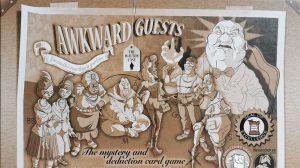Disclosure: Meeple Mountain received a free copy of this product in exchange for an honest, unbiased review. This review is not intended to be an endorsement.
I was born after the decline of the milkman. I live in a small town where the idea could almost live again. Folks around these parts walk to pick up milk from their organic suppliers, but no one dons the cap and uniform for house calls. I have fond childhood memories of food deliveries, helping the mailman with his daily rounds, and, obviously, the daily passing of the ice cream truck. There’s some nostalgic romance in those aspects of bygone days, I guess.
The whole home delivery scene is appealing as a setting for a game. Milkman, from Dice Hate Me Games, puts players in charge of the whole operation—from farm to front door.
Raw
Milkman is a dice-chucker. Players each roll their two black dice on every turn. With two possible rerolls, they then make the best of their results and take action. The active player also receives a single roll of four white dice, granting a few extra options and first dibs in selecting customers for the turn.

On the dice, cows produce raw milk that is stored in tanks with limited capacity. Bottles convert an entire tank into whole, skim, or chocolate, stored in refrigeration with its own limits. Cash gives wooden cash tokens. Meeple select customer cards from a pool of four, adding the customer to a particular geographic zone on their player board. Meeple might also upgrade—more cows, another tank, a bigger truck. Trucks load, drive, and drop milk to thirsty folk. Broken bottles lock when rolled and force the discard of a customer card. Doubles can be counted as a wild.
The trick is efficiency. You want the right number of cows to adequately fill the tanks. You want to keep deliveries cycling the milk so you aren’t overstocked (unless you want to be). You want to get customers in line so the truck can make multiple deliveries on a single trip. You want the cash to upgrade your life to keep the levels in balance. It all makes sense.
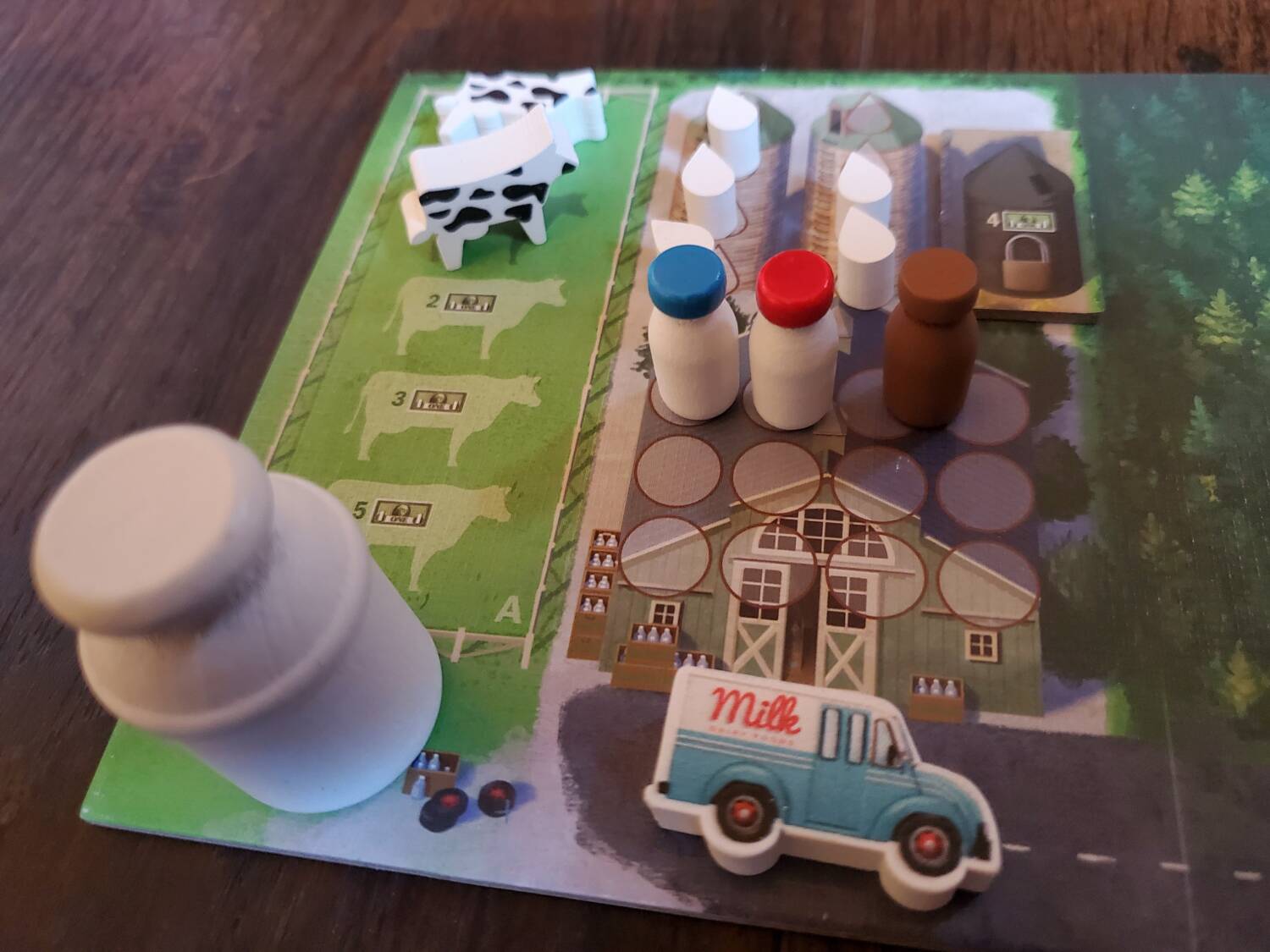
The backside of the board, the “Advanced” variant, feels like the more typical experience. The front side only scores points for delivered milk, creating a singular point of emphasis and a slight dependence on the right customers being available. That focus, however, might be the more challenging system. The backside scores points for certain upgrades, incentivizing the building of a widely useful operation without neglecting the need to deliver. It feels cozy and familiar.
A threefold Inspansion is included in the box. Three sets of cards shake up play at various levels. Private player objectives create some conflicting desires—have the most stored chocolate milk at the end of the game, for example. Public objectives fall to the first player to accomplish the task. Finally, events alter the landscape ever so slightly for the round. Again, these are the “normal” board game experience, allowing players to build a score from a well-rounded set of options instead of a narrow, singular pursuit.
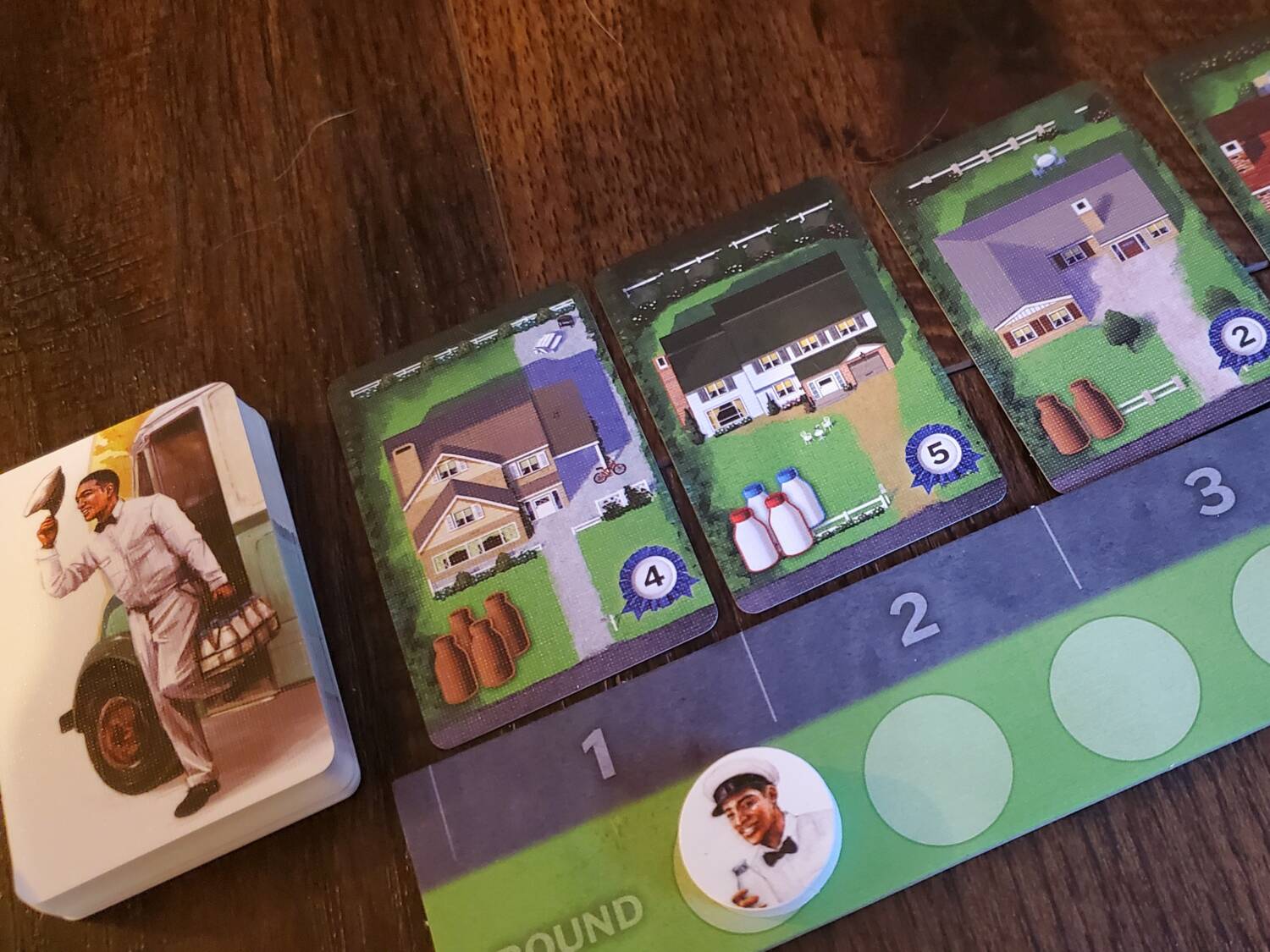
After a set number of rounds, during which each player becomes the lead player once, the game ends.
Bottled
In looking through the information for the game, I watched the preview video staged before the crowdfunding campaign. After receiving the finished game, I believe I would have been less frustrated with the prototype components. The bottles for Milkman might be the most maddening component I’ve faced in a long time. The game’s entire storage philosophy is that milk bottles stand. Sensible. But these bottles don’t stand for long. The slightest shake to the table, the slightest bump of the board—breathing, even—these are the enemies of the skinny little wooden bottles. From the first round of the first game, we started laying them down in front of our player board. The only reason we weren’t cursing is because I was playing with one of my kids. It just doesn’t work, and it really ruins things in a game about handling bottles of milk. Compounding the issue, the raw milk droplets would suit a Tiny Epic version of Milkman. They work, but they are ultra-tiny.
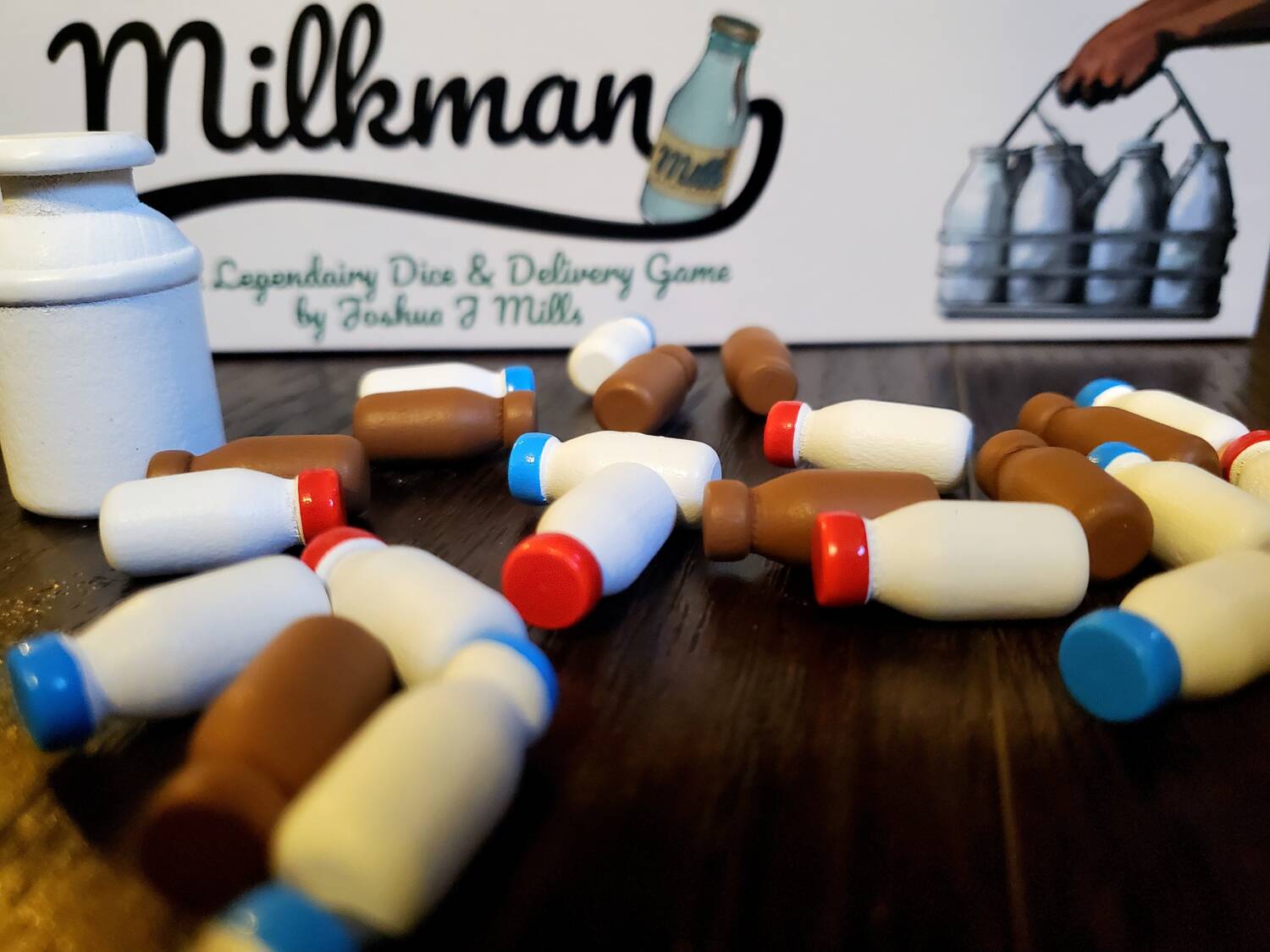
Those quibbles aside—and I cannot stress how significant they are from a gameplay perspective—the rest of the production is pretty cool. The boards lay flat right out of the box. The trucks are fun to drive out and back. The inclusion of the little truck board makes sense, though it would be so cool to have the bottles actually in a truck. I understand the limitation, it would take a big truck, nay, two big trucks to accommodate the possibility of upgrading in the game. The cows lay nice, the iconography is clean, and the whole aesthetic is perfect for the intended 1950s evocation.
I love most of the production, but I long for the simple little themeless bottle cylinders from the prototype.
Loaded
Milkman is super simple in concept. Apart from a few decisions regarding cash and dice manipulation (rerolls or choosing a die face in exchange for some dollar bills), the game runs smoothly. The active player takes a bit longer than everyone else—maybe a little too long. Laying out and rerolling for six options can take a minute, a palpable passage of time when the rest of the table has only two. If you happen to be going to the customer market with your two dice, you might have to wait for the first player to get their life in order since they have precedence.
I suppose you could even out the distribution of playtime by tinkering with the dice. Three black dice for all instead of two, and only three white dice instead of four, but that would skew the possibilities in the dice. The real advantage, beyond sheer numbers, to the first player is the high probability of doubles and the subsequent wild option. It’s a lot easier to get what you want with six total dice, and a designed advantage over those who have less. I’m reminded of Dice Forge in the way players slowly stock up while waiting to unleash on their active turn. Sometimes an off turn becomes a massive delivery action, but sometimes you’re just stockpiling cash and your tanks to get ready for the big move.
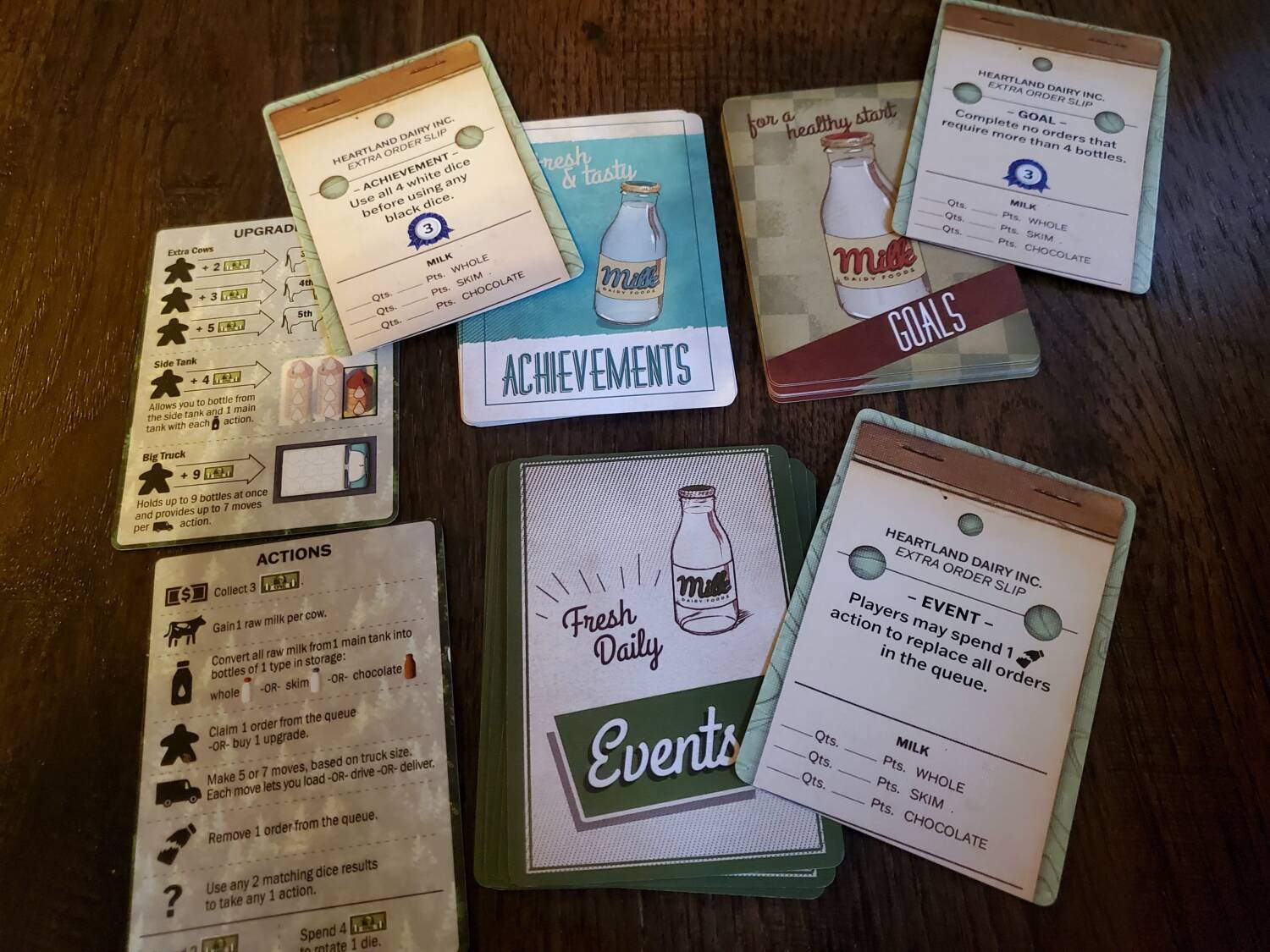
Overall, I think I enjoy the dice mechanism of Wok and Roll a bit more for this style of game. There a single player rolls all the dice, rerolling according to their wants and needs, and that active player has a special color of dice that belong only to them. It’s a bit less clunky and uneven, even if downtime is still an issue.
The broken bottles are a fascinating mechanic. In rolling, they are obviously punitive because they lock, requiring cash to change them. But as doubles, they become opportunities as a wild action. In addition, the forced discard is often helpful to cycle the cards at lower player counts. They may also be devious to jettison an opponent’s best customer before they get the chance to claim and deliver.
As for deliveries, I also like the idea of the zones on the map. Each player board has four zones, with the third and fourth granting a bonus because of the extra required distance. Better yet, as cards enter the market, they fall into corresponding zone markers that determine where they will sit once claimed. The zone layout, milk production, delivery capacity, and potential bonus all converge on a choice of cards.
Delivered
I cannot express how disappointing the milk bottles are in a game like this. The player board and the truck bed stare you down like wasted aesthetic opportunities as you lay the bottles on their sides in frustration. Games bits should work, and when they don’t—especially in a game as evocative as Milkman needs to be—it’s hard to overlook. Depending on your table mates, the downtime can also be an issue. Folks who freeze in the face of possibilities, and children, will definitely slow the process. I offer these as cautions.
Otherwise, Milkman plays consistently. The straight delivery race offers a chance to test your milk-engine-building mettle with all the marbles in the final result. With all the bells and whistles in play, there’s a well-rounded little dice game in here—smooth as a glass of two-percent. With a speedy table, it’s easy to knock out a game in 30-45 minutes. Every minute beyond that is noticeable downtime. Take that as you will. I admit I was hoping this one would strike a particular chord, but it missed the mark.







